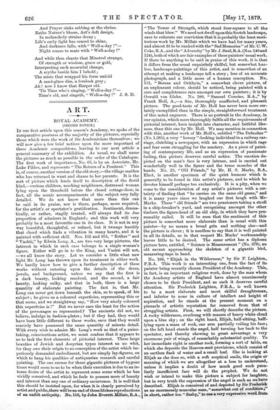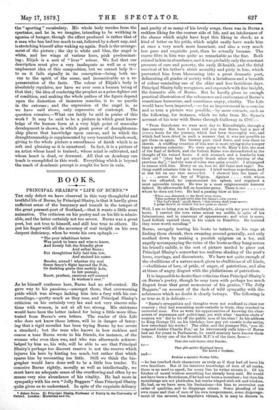ART.
ROYAL ACADEMY.
[SECOND NOTICE.]
Is our first article upon this season's Academy, we spoke of the comparative poorness of the majority of the piotures, especially those which were the work of the Academicians themselves ; we will now give a few brief notices upon the more important of these Academic compositions, leaving to our next article a general summary of the exhibition. As usual, we shall name the pictures as much as possible in the order of the Catalogue. The first work of importance, No. 63, is by an Associate, Mr. Luke FiMes, and represents "The Return of a Penitent." This is, of course, another version of the old story,—the village maiden who has returned in want and shame to her parents. It is the sort of picture which lends itself to description of the florid kind,—curions children, mocking neighbours, distressed woman lying upon the threshold before the closed cottage-door, in fact, all the scenic accompaniments of the subject very fully detailed. We do not know that more than this can be said in its praise, nor is there, perhaps, more required, for the artist's or spectator's gratification. Sentiment, drama- tically, or rather, stagily treated, will always find its due proportion of admirers in England; and this work will very probably be a most favourite one in its class. It is not in any way beautiful, thoughtful, or refined, but it twangs harshly that chord which finds a vibration in many hearts, and it is painted with sufficient skill. Nos. 102 and 955, " Esther " and " Vashti," by Edwin Long, A., are two very large pictures, the interest in which in each case belongs to a single woman's figure. Esther will go in to the King, and Yashti will not, —we all know the story. Let us consider a little what new light Mr. Long has thrown upon its treatment in either work. We hardly know how to give a further description of these works without entering upon the details of the dress, jewels, and background, unless we say that the first is a dark beauty, looking resolved, and the second, a fair beauty, looking sulky, and that in both, there is a large quantity of elaborate painting. The fact is, that Mr. Long can never get down beneath the skin, so to speak, of his subject ; he gives us a coloured superficies, representing this or that scene, and we straightway say, "How very nicely coloured this superficies is !" But we never care the least for the action of the personages so represented ? The ancients did not, we believe, indulge in fashion-plates ; but if they had, they would have been little different to these works, save that they would scarcely have possessed the same quantity of minute detail. With every wish to admire Mr. Long's work as that of a pains- taking, conscientious artist, we must confess that it appears to us to lack the first elements of pictorial interest. These large beauties of Jewish and Assyrian types interest us no whit, for they owe their origin to no conception of the artist which im- periously demanded embodiment, but are simply lay-figures, on which to hang his qualities of antiquarian research and careful painting. The one excuse for these gigantic pictures of bygone times would seem to us to be when their execution is due to an in- tense desire of the artist to represent some scene which he has vividly conceived, and which he feels to possess more of beauty and interest than any one of ordinary occurrence. It is well that this should be insisted upon, for when it is clearly perceived by artist andpublic, there willbe an end of theselifelessreproductions of an unfelt antiquity. No.150, by john Everett Millais, R.A.,
"The Tower of Strength, which stood four-square to all the. winds that blew." We need not dwell uponthis Scotch landscape, save to reiterate our conviction that it is probably the least meri- torious work by Mr Millais which we have had for many years, and almost fit to be ranked with the" SadMemories " of Mr. C. W..
Coke, R.A., and the" Adversity" by Mr. J. Saul, R.A . (Nos. 140 and.
124), both of which are fair examples of these painters' usual work.. If there be anything to be said in praise of this work, it is that it differs from the usual exquisitely skilful, but somewhat hue- less, landscape-paintings of this artist, and is somewhat of an attempt at making a landscape tell a story ; less of an accurate-
photograph, and a little more of a human conception.. No.. 151, " Boreas and Orithyia," a somewhat clever picture, of an unpleasant colour, should be noticed, being painted with a care and completeness rare amongst our own painters ; it is by
Oswald von Glehn. No. 189, "Samuel Cousins, R.A.," by- Frank Roll, A.,—a fine, thoroughly unaffected, and pleasant
picture. The good-taste of Mr. Roll has never been more cer- tainly exemplified than in the simple, straightforward treatment of this noted engraver. There is no portrait in the Academy, in our opinion, which more thoroughly fulfils all the requirements of pictorial interest, keen insight into character, and faithful like- ness, than this one by Mr. Roll. We may mention in connection with this, another work of Mr. Roll's, entitled "The Defaulter (No. 1,385), a very "horsey "-looking individual in a railway car- riage, clutching a newspaper, with an expression in which rage and fear seem struggling for the mastery. As a piece of paint- ing of contemporary life, and as an expression of passionate feeling, this picture deserves careful notice. The emotion de- picted on the man's face is very intense, and is carried out wonderfully well in the figure and the tense muscles of the hands. No. 25, "Old Friends," by Mr. H. S. Marks, R.A. Elect, is another specimen of the quiet humour which is generally to be found, in this artist's pictures, and to which he devotes himself perhaps too exclusively. It is a pity, when we come to the consideration of any artist's pictures with a cer- tainty of finding that "he carries on the same old game," and it is many years since we laughed our first laugh with Mr.- Marks. These "old friends" are two pensioners taking a Aron in a ship-breaker's yard, and recognising amongst the other timbers the figure-head of an old ship, in which they have pre- sumably sailed. It will be seen that the sentiment of this picture is somewhat more elaborate than is usual with this painter—by no means a broad grin and nothing else—and the picture is clever ; it is needless to say that it is well painted in all its details, as in that respect Mr. Marks' workmanship- leaves little to be desired. The same artist has a diploma picture here, entitled, "Science is Measurement" (No. 379), an old savant approaching the skeleton of a gigantic bird, measuring-tape in hand.
No. 188, "Elijah in the Wilderness," by Sir F. Leighton,. P.R.A. This work is an interesting one, from the fact of its painter being recently chosen President of the Academy. This,. in fact, is an important religious work, done by the man whom the Academy artists of England have almost unanimously chosen to be their President, and as such it deserves careful attention. -Sir Frederick Leighton, P.R.A., is well known to be a most elaborate and most skilful draughtsman, and inferior to none in culture of intellect and height of aspiration, and he stands at the present moment on a pinnacle of artistic reputation far removed from that of struggling artists. First, we will shortly describe the picture. A rocky wilderness, overhung with masses of heavy white &mid upon a blue sky ; on the right hand, Elijah, half-sitting, half- lying upon a mass of rock, one arm partially veiling his face;. on the left hand stands the angel, half turning her back to the spectator, and thereby showing to great advantage a very enormous pair of wings, of remarkably substantial quality. To. her immediate right is another rock, forming a sort of table, on which she deposits the Heaven-sent provisions, which consist of an earthen flask of water and a small loaf. She is looking at- Elijah as she does so, with a soft sceptical smile, the origin or- meaning of which we are altogether at a loss to understand,. unless it implies a doubt of how much good such pecu- liarly insufficient fare will do the prophet. We do not wish or intend to make this picture a subject for laughter, but in very truth the expression of the angel is such as we have described. Elijah is conceived of and depicted by Sir Frederick as an enormously muscular man," somewhat out of condition;" in short, zather too "fleshy," to use a very expressive word. from the "sporting" vocabulary. His whole body recedes from the spectator, and he is, we imagine, intending to be writhing in agonies of hunger, though the effect produced is rather that of a man who has had too much to eat, followed by a short nap, and is stretching himself after waking up again. Such is the arrange- ment of the picture ; the sky is white and blue, the angel is white, and her wings of various hues, pink predominat- ing; Elijah is a sort of " liver " colour. We feel that our -description must give a very inadequate as well as a very unpleasant idea of this composition, but we cannot help it— to us it fails signally in its conception—being both un- rue to the spirit of the scene, and inconceivable as a re- presentation of the facts. The colour of Elijah's body is absolutely repulsive, nor have we ever seen a human being of that tint; the idea of rendering the prophet as a prize-fighter out of condition, and making the whole pathos of the figure depend upon the distortion of immense muscles, is to us puerile in the extreme ; and the expression of the angel is, as we have said above, only expressive of contempt. The question remains,—What can fairly be said in praise of this 'work P It may be said to be a picture in which great know- ledge of the human form at a very high point of muscular development is shown, in which great power of draughtsman- ship places that knowledge upon canvas, and in which the draughtsmanship is supplemented by very beautiful brush-work, giving to the whole picture a smoothness of finish which is as soft and pleasing as it is unnatural. In fact, it is a picture of an artist whose hand is trained ; whose mind is cultivated, and whose heart is dead, or dormant. All that an Academy can teach is exemplified in this work. Everything which is beyond -the reach of Academic precept is sought for here in vain.



































 Previous page
Previous page